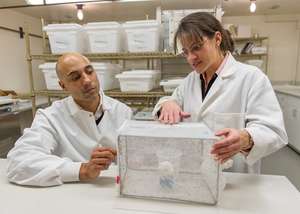Understanding behavior key to combating malaria

April 25 is World Malaria Day. This year's theme – End Malaria for Good – seeks to build upon past successes in combatting this deadly disease, which killed over 435,000 people in 2015, and sustain this progress in order to truly "end malaria for good."
At the University of Notre Dame, Neil Lobo, a research associate professor of biological sciences and an Eck Institute for Global Health faculty member, is working to end malaria for good by focusing on the vectors that transmit the disease and how certain methods or interventions reduce malaria transmission.
"Each mosquito species has different behaviors that determine when or where they feed," said Lobo. "These behaviors make up a mosquito's life cycle and help us determine when people are most at risk for transmission."
Lobo uses molecular techniques to characterize disease transmission and mosquito population structures and movements. This helps identify what species are acting as vectors within a certain region as well as their life cycles. He then uses this information and overlays it with traditional or novel interventions that target when a mosquito will be most active or feeding to prevent possible transmission.
The World Health Organization recommends all those living or visiting countries at risk to use insecticide-treated bed nets (ITNs) and indoor spraying with residual insecticides to combat mosquito to human malaria transmission. However, Lobo recognizes that traditional interventions are not a one-size-fits-all solution.
"ITNs take advantage of mosquitos that bite late at night and indoors," explained Lobo. "If mosquito species are infecting people outside the home or during another time of day, the ITNs will have a limited impact. Our research is used to help find the most applicable interventions based on the needs of each location where my team and I work."
Even though there are hundreds of potential mosquito species that can act as vectors, there are only four primary different species of the Plasmodium parasite, which is the parasite that causes the disease, that infect humans. By tracing parasite populations that are infecting a certain location, researchers can more easily discover if malaria is being locally circulated or if there are cases being imported through human migration.
"Human movement and behavior can have just as much of an impact on malaria transmission as mosquito behaviors do," said Lobo. "In fact, in Indonesia we found that there were all of these cases of malaria popping up at a specific time. After looking at human behavior, we found that people were actually traveling home for a religious holiday and taking malaria with them." While human movement is not a specific focus of Lobo's work, this aspect of tracking and mapping this disease is important to consider and demonstrates how complex the transmission system may be.
Lobo travels to several different research sites in multiple countries in Asia, the Pacific, Africa, and South America on a regular basis. Together with Nicole Achee, research associate professor of biological sciences and Eck Institute for Global Health affiliated faculty member, he is working on concluding several malaria research projects focusing on the impact of spatial repellents as an intervention, how malaria spreads in different locations, and the characterization of new mosquito species, their behaviors, and how these impacts transmission towards the development of better intervention strategies.



















